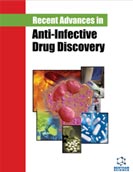Abstract
Background: The human respiratory syncytial virus (RSV) is responsible for causing upper and lower respiratory tract infections in young children. RSV Fusion (F) protein is a surface glycoprotein that facilitates virus entry into host cells. Thus, newer designing of RSV Fusion (F) protein inhibitors is required on an urgent basis.
Methods: In the present study, we have developed statistically robust. Quantitative structure-activity relationship (QSAR) models for the effective designing of newer analogues of piperazinylquinoline derivatives (H1-H12).
Results: Our developed models were retained with high statistical parameters (R2 > 0.6 and Q2 > 0.5). Our developed pharmacophore, model (AADHRR_2) (indicating that two hydrogen bond acceptors, one hydrogen bond donor, one hydrophobic group, and two aromatic rings) is crucial for retaining the activities of piperazinylquinoline derivatives against RSV. Moreover, docking analysis of 12 new analogues on RSV pre-F in complex with 5C4 Fab (PDB ID: 5W23) and post-F trimeric protein (PDB ID: 3RRR) suggested higher affinities of these molecules against studied targets with good docking scores.
Conclusion: Thus, one can implement developed QSAR models, docking analogy and Pharmacophore models for identifications of potent leads for designed molecules as RSV Fusion (F) protein inhibitors.
Graphical Abstract
[http://dx.doi.org/10.1007/s12016-013-8368-9] [PMID: 23575961]
[http://dx.doi.org/10.1097/00063198-200205000-00011] [PMID: 11981311]
[http://dx.doi.org/10.1016/j.coph.2014.03.008] [PMID: 24810284]
[http://dx.doi.org/10.1002/ppul.21377] [PMID: 21438168]
[http://dx.doi.org/10.1164/ajrccm.163.supplement_1.2011109] [PMID: 11254543]
[http://dx.doi.org/10.1002/14651858.CD000181.pub4] [PMID: 20464715]
[http://dx.doi.org/10.1542/peds.102.3.531]
[http://dx.doi.org/10.1006/viro.2000.0293] [PMID: 10860881]
[http://dx.doi.org/10.1073/pnas.260499197] [PMID: 11106388]
[http://dx.doi.org/10.1128/JVI.79.2.1113-1124.2005] [PMID: 15613339]
[PMID: 14227873];
b) Witvrouw M, De Clercq E. Sulfated polysaccharides extracted from sea algae as potential antiviral drugs. Gen. Pharmacol. 1997; 29(4): 497-511.
[http://dx.doi.org/10.1016/S0306-3623(96)00563-0] [PMID: 9352294];
c) Kimura K, Mori S, Tomita K, et al. Antiviral activity of NMSO3 against respiratory syncytial virus infection in vitro and in vivo. Antiviral Res. 2000; 47(1): 41-51.
[http://dx.doi.org/10.1016/S0166-3542(00)00091-7] [PMID: 10930645]
[http://dx.doi.org/10.1016/j.antiviral.2003.07.004] [PMID: 14638397]
[http://dx.doi.org/10.1016/j.bmcl.2006.11.063] [PMID: 17169560]
[http://dx.doi.org/10.1021/jm5017768] [PMID: 25574686]
[http://dx.doi.org/10.1128/JVI.77.9.5054-5064.2003] [PMID: 12692208]
[http://dx.doi.org/10.1021/acsmedchemlett.5b00008] [PMID: 25941547]
[http://dx.doi.org/10.1128/AAC.48.2.413-422.2004] [PMID: 14742189]
[http://dx.doi.org/10.1016/j.antiviral.2010.10.004] [PMID: 20965215]
[http://dx.doi.org/10.1128/AAC.02576-20] [PMID: 33782012]
[http://dx.doi.org/10.1016/j.bmc.2021.116157]
[http://dx.doi.org/10.1080/07391102.2019.1621213] [PMID: 31107179];
b) Glide, The advances of computational docking. Schrodinger. NY: LLC 2017. Available from:https://www.schrodinger.com/products/glide
[http://dx.doi.org/10.1021/acsmedchemlett.5b00234] [PMID: 27326326]
[http://dx.doi.org/10.1038/s41598-017-17689-0] [PMID: 29234123]
[http://dx.doi.org/10.1016/j.jmgm.2010.05.008] [PMID: 20579912];
b) Sastry M, Lowrie JF, Dixon SL, Sherman W. Large-scale systematic analysis of 2D fingerprint methods and parameters to improve virtual screening enrichments. J. Chem. Inf. Model. 2010; 50(5): 771-84.
[http://dx.doi.org/10.1021/ci100062n] [PMID: 20450209];
c) Hert J, Willett P, Wilton DJ, et al. Enhancing the effectiveness of similarity-based virtual screening using nearest-neighbor information. J. Med. Chem. 2005; 48(22): 7049-54.
[http://dx.doi.org/10.1021/jm050316n] [PMID: 16250664]
[http://dx.doi.org/10.1007/s00044-018-2250-5]
[http://dx.doi.org/10.1007/s11224-022-01879-2]
[http://dx.doi.org/10.2174/1573408017666210914105731]
[http://dx.doi.org/10.3390/ASEC2021-11185]
[http://dx.doi.org/10.1016/j.jics.2021.100088]
[http://dx.doi.org/10.2174/1573409916666200615141047] [PMID: 32538732]
[http://dx.doi.org/10.1002/slct.202101083]
[http://dx.doi.org/10.1016/j.jics.2021.100082]
[http://dx.doi.org/10.1142/S2737416521500125]
[http://dx.doi.org/10.1007/s13659-020-00284-8] [PMID: 33175328]
[http://dx.doi.org/10.2174/15734099MTA0sOTQ3x] [PMID: 32141422]
[http://dx.doi.org/10.2174/1386207323666200605150915] [PMID: 32503404]
[http://dx.doi.org/10.3390/ASEC2021-11157]
[http://dx.doi.org/10.2174/1573408017666210203203735]
[http://dx.doi.org/10.2174/1573408016999201026200650]
[http://dx.doi.org/10.2174/1573409915666191210125647] [PMID: 31820704]
[http://dx.doi.org/10.2174/1386207322666190722162100] [PMID: 31438831]
[http://dx.doi.org/10.2174/1573409915666191018120611] [PMID: 31648645]
[http://dx.doi.org/10.2174/1573409915666190902143648] [PMID: 31475902]
[http://dx.doi.org/10.2174/1386207323999200325125858] [PMID: 32209038]
[http://dx.doi.org/10.1142/S2737416522500387]
[http://dx.doi.org/10.1007/s42250-022-00462-w]
[http://dx.doi.org/10.1007/978-3-030-99476-1_18]
[http://dx.doi.org/10.1016/j.medidd.2019.100008]
[http://dx.doi.org/10.1142/S2737416521410015]




























